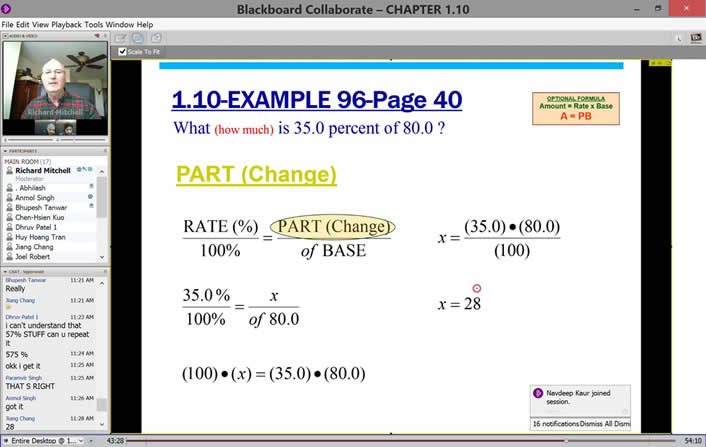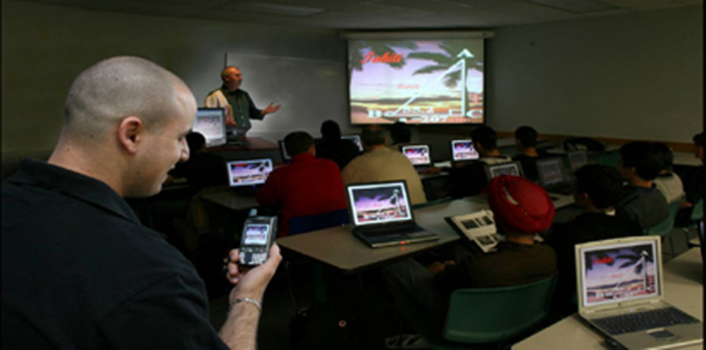Key Takeaways
- This case study explains how SMILE — Synchronous Mobile Interactive Learning Environment — allows the instructor to present and record lessons anywhere, anytime, on any device.
- With SMILE, students interact in virtual classrooms, in real time, using features such as whiteboards, audio, video, chat rooms, polling, application sharing, and/or closed captioning.
- SMILE lets the instructor address student needs ranging from travel restrictions to barriers imposed by geographic, economic, or physical constraints.
- Integrated face-to-face and online instruction maximizes student interactivity and accessibility through embedded principles of Universal Instructional Design, so students feel more engaged both in and outside of the classroom.
Richard Mitchell, Professor, Mathematics Department, Humber College
Imagine a class with no boards, no walls, and no boundaries…
Lessons taught with blackboards, overheads, or PowerPoints no longer engage a generation that has grown up with Google Glass, augmented reality, and the cloud. Nor does the traditional model of lecture, notes, and homework support those who require resources beyond the set classroom boundaries. Furthermore, traditional teaching methods do not address the needs of many students who cannot travel, for various reasons, to a physical classroom or who face barriers imposed by geographic, economic, or physical constraints.
SMILE is a Synchronous Mobile Interactive Learning Environment that addresses these concerns by allowing the instructor to present and record lessons in real time anywhere, anytime, and on any mobile device.
Anytime, Anywhere, Any Device
With SMILE, students interact in virtual classrooms using features such as whiteboards, audio, video, chat rooms, polling, application sharing, and/or closed captioning. The instructor uses a web conferencing tool such as Blackboard Collaborate and a tablet to present live sessions anywhere there is a wireless signal. Lessons and discussions are recorded and accessed through a learning management system, which helps students prepare for exams or review missed lessons. The instructor also has the option to create flipped classroom videos. The result is a rich, engaging collaborative environment, which helps improve students' attitudes, attendance, and overall achievement.
SMILE can be used in a traditional classroom, online, or in a hybrid-blended model and adapts to the needs of the student regardless of physical or social barriers. SMILE also takes advantage of existing technologies such Windows, iOS, and Android mobile devices and students' interest in social media such as YouTube and SMS.
In the fall 2014 semester, in response to a need for flexibility, increased student engagement, and improved accessibility, the Mathematics Department at Humber College piloted a hybrid model that provided both a synchronous (face-to-face streaming) and asynchronous (video recordings) option for those students who preferred a physical classroom as well as those who enjoyed the flexibility of online virtual classes. As professor of the pilot class, half of my lessons were taught online in real time using Blackboard Collaborate, and half were delivered F2F in a traditional classroom. The in-class lessons were streamed live, and recorded lessons were made available on the students' Blackboard Learn website.

Accessible by Anyone
Extending the learning beyond the limitations of the classroom has provided opportunities for students to learn both at home and in the classroom, with their teacher, independently, or with each other even when not on campus.
Focused on student-centered and inclusive design principles, the SMILE model has demonstrated a noticeable increase in student satisfaction scores as shown on student feedback questionnaires and follow-up online surveys. Students submit comments such as "loved the flexibility and convenience" and "why don't other teachers SMILE?" One student, who had muscular dystrophy, told me how much he appreciated the fact that he could take classes live and online from home. The synchronous and asynchronous aspects of SMILE made learning more accessible to this student, who otherwise would have missed some of his lessons.
The hybrid SMILE model also supports opportunities to apply active learning methods such as inquiry-based learning. In my pilot study, group presentations were recorded by the students on their mobile devices and uploaded onto my YouTube site.
Piloting SMILE
Participants in the SMILE pilot came from a variety of technology-based math programs. However, the SMILE model can be implemented for almost any discipline and at virtually any college. Anyone who knows how to Skype and can use a mobile device can learn how to use SMILE in just a few weeks. Set-up is quick and costs are minimal, as most students already have a mobile device or laptop and many colleges already have an LMS. At Humber College, the Blackboard Learn 9.1 platform is available to all students and staff, and many instructors have already attended web conferencing workshops. Although cutting-edge technology is used, the SMILE model builds on a philosophy based on inclusive design principles. It also relies on existing resources and makes the learning experience interactive, accessible, and mobile.

As with many new implementations, the SMILE pilot experienced some minor difficulties with Wi-Fi and equipment. Overall, though, reliability has been impressive. For example, on one occasion an entire lesson was successfully broadcast on a 5 Mbps signal from a conference center in Texas to students at home in Toronto. Note, however, that students and faculty participating in alternative delivery methods need training. Those who are well versed in mobile technologies learn quickly, but those unfamiliar with smartphones and mobile apps may experience some difficulty.
Second, some platforms work better with certain devices. Some tools use Java, whereas others are HTML5 or cloud based. The Blackboard Collaborate tool supports video and interactive whiteboard features on a Windows platform, but does not support these features on iOS or Android devices. Audio and text are available on these devices, but if full mobility is important, then the teaching style may need to be adapted to accommodate each device or platform. Moreover, less expensive platforms such as Google Hangouts could be used, but I recommend caution because of privacy issues.
Finally, teachers must be prepared to redefine their roles. Traditionalists who prefer to lecture on blackboards may not want to learn this new approach to teaching.
A New Path for Classroom Instruction
In the NMC Horizon Report: 2014 Higher Education Edition, the integration of online, hybrid, and collaborative learning in face-to-face instruction is highlighted as "one of two fast trends … that will be driving changes in higher education over the next one to two years." More recently, the NMC Horizon Report: 2015 Higher Education Edition predicted that blended learning and redesigned learning spaces will gain increasing prominence over the next one to two years.
To address these challenges, SMILE integrates face-to-face and online instruction in order to maximize student interactivity and accessibility by incorporating principles of Universal Instructional Design, making learning resources more accessible so that students feel more engaged both in and outside of the classroom.
As educators, our challenges should not define us. Rather, our actions should guide us to identify and eliminate unnecessary barriers to teaching and learning. SMILE comes close to realizing this goal by integrating technologies into the classroom in a way that leaves no one behind.
Award-Winning SMILE
The SMILE model recently won the 2015 League Innovation of the Year Award and a NISOD Award for Teaching Excellence. For more information about using SMILE, contact me at [email protected].

